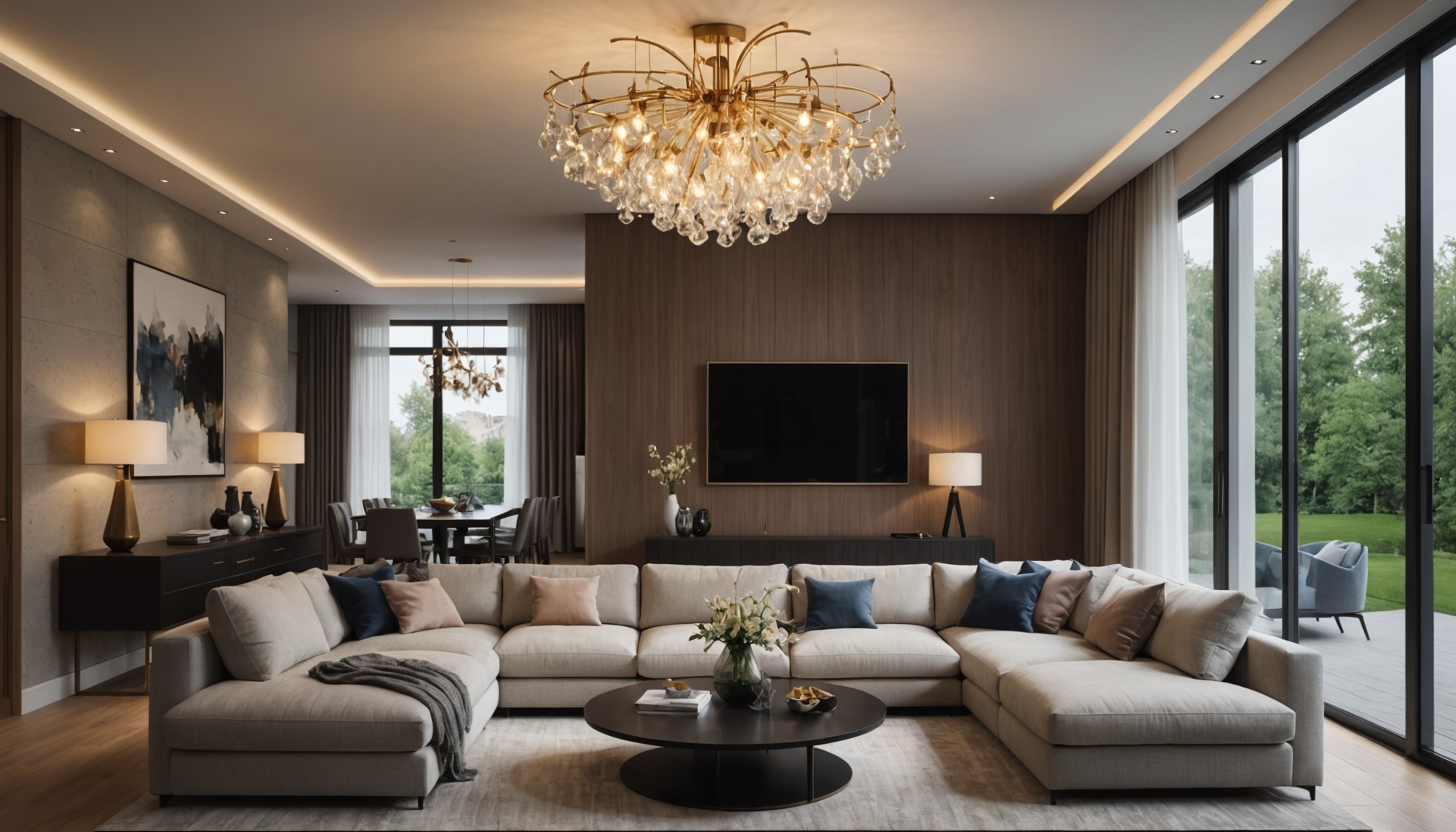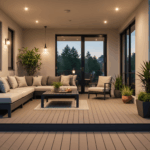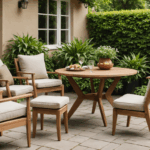The living room serves as the heart of your home, a space where relaxation, conversation, and entertainment seamlessly converge. Crafting the perfect lighting strategy for this multifaceted area involves a blend of functionality and aesthetics. To achieve a well-lit living room that meets various needs, explore a mix of ambient, task, and accent lighting.
Ambient lighting forms the foundation, providing a soft, all-around glow that ensures comfort without overpowering the senses. Adjustable ceiling fixtures or dimmable chandeliers are ideal for establishing versatile illumination. Strategically placing these fixtures allows for an even distribution of light, enhancing the room’s spaciousness while adapting to different moods.
For activities that require focused light, such as reading or intricate hobby work, task lighting becomes essential. Incorporate floor lamps next to your favorite reading chair or desk lamps for added brightness. Consider options with adjustable arms and energy-efficient LED bulbs to tailor the light’s direction and intensity, ensuring they meet specific requirements without causing glare.
Accent lighting plays a crucial role in highlighting specific areas or features within the living room. Whether it’s a piece of art, an architectural detail, or a textured wall, use track lighting or spotlights to draw attention and create depth. Accent lighting adds layers to the room, enhancing its visual appeal while contributing to the overall ambiance.
When planning your living room lighting scheme, consider the following elements to enhance both functionality and aesthetics:
- Use a layered lighting approach by combining different types of lighting fixtures to create a harmonious effect.
- Select fixtures that complement the room’s style and color palette to ensure cohesiveness in design.
- Incorporate smart lighting systems that allow for easy adjustments through apps or voice-activated commands, offering convenience and energy-saving benefits.
To help compare the different types of lighting and their effects, consider the following table:
| Lighting Type | Purpose | Best Used For |
| Ambient | Overall illumination | Ceiling fixtures, chandeliers |
| Task | Specific activities | Reading lamps, desk lamps |
| Accent | Highlighting features | Spotlights, track lighting |
Material selection and bulb types also impact both aesthetic and energy efficiency. Opt for lighting fixtures made from sustainable materials, and choose LED or CFL bulbs for long-lasting, environmentally friendly solutions.
Careful planning of living room lighting strategies can elevate the space, adding warmth and character while ensuring it’s both practical and inviting. Through thoughtful integration of various lighting types, your living room can achieve a perfect balance of style and utility.
Kitchen lighting solutions
In the kitchen, good lighting can transform your cooking and dining experience, making it more enjoyable and efficient. When designing the lighting for this essential space, consider a combination that covers all corners while ensuring adaptability for different activities. Here’s how you can achieve effective lighting throughout your kitchen:
- Assess Natural Light: Start by evaluating the natural light sources during different times of the day. Kitchens with ample windows might benefit from reduced artificial lighting during daylight hours, while darker kitchens require more installed lighting elements.
- Layered Lighting Approach: Implement a layered lighting scheme to cater to various tasks and create an inviting atmosphere. Include ambient, task, and accent lighting to cover all functionalities:
- Ambient Lighting: This serves as the primary source of light in your kitchen. Ceiling-mounted fixtures, such as flush-mount lights or larger pendants, can effectively provide broad illumination. Recessed lighting is another excellent option, helping to evenly distribute light across the entire kitchen.
- Task Lighting: Focus on areas where precise work occurs, like countertops and prep areas. Under-cabinet lighting is ideal for this purpose, shedding direct light on workspaces to enhance safety and precision in kitchen tasks.
- Accent Lighting: Use this to highlight specific areas and add a decorative touch. Consider installing lights inside glass-front cabinets to showcase dishware or adding LED strips above cabinets for a warm glow.
- Choose the Right Fixtures and Bulbs: The type of fixtures and bulbs play a crucial role in the kitchen ambiance and practicality. Select fixtures that complement your kitchen’s design theme while also considering:
- Color Temperature: Opt for bulbs that range from 2700K to 3500K for warm to neutral white light, creating a comfortable and welcoming atmosphere.
- Energy Efficiency: LEDs are recommended for kitchens due to their long lifespan and energy-saving features. They also emit less heat, which can be beneficial in a busy kitchen environment.
- Consider Dimmers and Smart Lighting: For greater flexibility, install dimmers on main light sources to adjust brightness to different tasks or times of day. Smart lighting systems can be a great addition, allowing you to control kitchen lighting settings via a smartphone app or voice commands, offering convenience and energy efficiency.
- Safety Considerations: Ensure that all lighting fixtures and bulbs are rated for kitchen use, particularly in areas prone to moisture and heat, such as above the stove or sink. Install fixtures at appropriate heights and locations to prevent shadows on work surfaces.
By carefully planning and combining various lighting types, you can create a kitchen environment that is both functional and aesthetically pleasing, allowing for efficient cooking, dining, and socializing in a bright, welcoming space.
Bedroom ambiance lighting
Creating a serene and restful retreat in your bedroom is best achieved with a strategic approach to lighting, where the interplay between light sources can significantly influence mood and comfort. By focusing on layered lighting, soothing tones, and strategic setups, you can transform your bedroom into a sanctuary of relaxation and rejuvenation, perfectly tailored to your personal tastes.
Begin with ambient lighting, the base layer that introduces a soft, uniform glow throughout the room. This type of lighting ensures that the entire space feels inviting and secure without creating high-contrast areas that might disrupt relaxation. Consider installing flush-mount ceiling fixtures or ceiling fans with integrated lights, which can distribute light evenly. For added versatility, incorporate dimmable options so you can easily alter the brightness according to your mood or activities.
Task lighting is crucial for specific activities like bedtime reading or cross-stitching. Place adjustable wall-mounted lamps or table lamps on bedside tables to provide the focused illumination needed in these circumstances. Opt for lamps with adjustable arms or pivoting heads, allowing you to direct light as needed and eliminate glare. Furthermore, select bulbs with a warmer color temperature, around 2700K to 3000K, which help maintain a cozy and calming environment conducive to winding down.
Incorporating accent lighting can add depth and interest to your bedroom, creating focal points and enhancing the spatial aesthetics. Use spotlights or track lighting to highlight art pieces, architectural details, or a textured headboard, fostering a sense of elegance and personal touch. Accent lighting also assists in building layers within the room, which is key to achieving a dynamic and ambient atmosphere.
Do not underestimate the power of decorative lighting elements such as fairy lights, lanterns, or even Himalayan salt lamps, which can add warmth and charm. These elements often double as both functional and ornamental contributors, elevating the bedroom’s overall look while gently illuminating darker corners.
To balance style and utility, consider energy-efficient options like LED bulbs, which not only reduce energy consumption but also have a significantly longer life span compared to traditional bulbs. Their availability in diverse designs and color outputs ensures you don’t need to compromise on visual appeal.
Lastly, explore the possibilities of smart lighting systems to enhance the convenience and flexibility of your bedroom lighting. These systems allow you to control light settings and automate routines with ease. Whether you want to gradually brighten the room as you wake or dim it as you prepare to sleep, smart lighting can facilitate creating a personalized lighting schedule, optimizing both your energy use and daily rhythm.
By combining these tailored lighting solutions, you can evoke the perfect blend of tranquility and functionality, ensuring that your bedroom becomes a haven for relaxation and rest, seamlessly fitting into your lifestyle and needs.
Bathroom brightness tips
When designing the lighting for a bathroom, it’s crucial to strike a balance between functionality and relaxation. Proper lighting in this space not only aids in day-to-day tasks but also transforms it into a tranquil retreat. Begin with an assessment of the bathroom’s size and natural light availability to tailor your approach effectively.
Ambient lighting is an essential first step. It serves as the primary source of illumination, creating a general brightness that mimics natural daylight. Opt for overhead fixtures like flush mounts, recessed lights, or ceiling-mounted chandeliers if space allows. These fixtures should be positioned to ensure even light distribution throughout the room, eliminating any harsh shadows that might occur.
Task lighting is particularly crucial in the bathroom, given the grooming and hygiene activities that take place. For precision in makeup application or shaving, consider installing vanity lights on either side of the mirror, ideally at eye level. This helps diminish shadows on your face, promoting accuracy and ease in these tasks. A horizontal fixture placed above the mirror as a supplement to side lights can offer an additional layer of illumination.
Accentuating certain features with accent lighting can enhance elements such as unique tiles, architectural niches, or a standalone bathtub. Use wall sconces or LED strips to softly illuminate these areas, creating a spa-like ambiance. These lights can double as night lights for safety, offering a soft glow during late-night visits without disturbing the peace.
Consider the lighting of the shower and tub areas, which often require targeted illumination due to their enclosed nature. Waterproof recessed lights or spotlights can provide the necessary brightness without posing risk of moisture exposure. Ensure that these fixtures are rated for wet locations to maintain safety standards.
Choosing the right fixtures and bulbs impacts both the aesthetic and energy efficiency of your bathroom lighting. Opt for fixtures with a sleek design that complements the room’s overall style. Bulbs in the warm white color range (around 3000K) are ideal for their flattering light that is still bright enough for tasks. Energy-efficient LEDs are recommended for their longevity and lower heat emission, a practical choice in spaces that are typically smaller and enclosed.
For added functionality, incorporate dimmer switches to adjust the brightness to suit varying needs throughout the day. Lower light settings can help create a more relaxing atmosphere during a bath, while brighter settings support grooming tasks. Smart lighting controls offer further customization, enabling you to set schedules or control lighting with voice commands.
Finally, ensure any electrical installations adhere to local building codes, particularly in moisture-prone areas. Professional installation and inspection can prevent potential hazards, giving you peace of mind as you enjoy your refreshed space.
By employing these strategies, you’ll not only enhance the usability of your bathroom but also craft a serene environment where you can unwind and rejuvenate, making it an integral part of your daily routine.
Home office light optimization
Optimizing lighting in a home office is crucial for fostering productivity and comfort. Lighting plays a significant role in reducing eye strain, enhancing mood, and creating an inviting workspace that encourages focus and efficiency.
Start by assessing the natural light available, as it can significantly influence the lighting setup needed. Position desks near windows to maximize daylight exposure, which can enhance mood and alertness. To mitigate glare, especially on computer screens, use sheer curtains or blinds, allowing for control over the intensity and direction of sunlight streaming in.
For artificial lighting, consider layering different types to achieve a well-rounded approach. Ambient lighting sets the foundation, ensuring your workspace is adequately illuminated. Ceiling-mounted fixtures or overhead recessed lights can provide uniform brightness across the entire room.
Task lighting is specifically vital in a home office setup. Desk lamps with adjustable arms allow for direct focus on your work area, reducing shadows and illuminating your immediate working surface. Opt for LED bulbs with a color temperature of around 4000K to 5000K, which simulate daylight and help maintain concentration and vitality.
Accent lighting contributes to the aesthetics of your workspace. Use LED strips or wall-mounted fixtures to highlight bookshelves or inspiring artwork, enhancing the room’s visual appeal and motivating creativity.
Equally important is choosing energy-efficient lighting solutions. Utilizing LED bulbs not only reduces energy consumption but also contributes to the longevity of your fixtures. These eco-friendly bulbs provide consistent illumination with minimal heat output, a benefit for any workspace.
Incorporate smart lighting systems to enhance flexibility. With these systems, you can adjust brightness levels throughout the day to match natural light patterns, reducing eye fatigue. Smart controls can also enable you to change light settings via an app or voice commands, providing convenience and the ability to swiftly adapt to various tasks or times of day.
Lastly, ensure your home office lighting setup also addresses ergonomics. Position lights strategically to avoid direct glare on your computer screen, which can lead to discomfort and eye strain over time. Consider installing anti-glare screens or using task lamps with diffused shading to create a balanced lighting scenario that optimizes workspace efficiency.
By carefully selecting and combining these lighting strategies, you can transform your home office into a dynamic, functional environment that fosters productivity and well-being.
In conclusion, tailoring your home’s lighting to suit each room’s unique needs brings both aesthetic and practical benefits. From creating a welcoming living room ambiance to enhancing kitchen functionality, promoting relaxation in the bedroom, ensuring sufficient bathroom brightness, and optimizing your home office, thoughtful lighting choices elevate your living experience. With a blend of ambient, task, and accent lighting, together with energy-efficient and smart solutions, you can foster environments that reflect your lifestyle while enhancing comfort and efficiency throughout your home.


